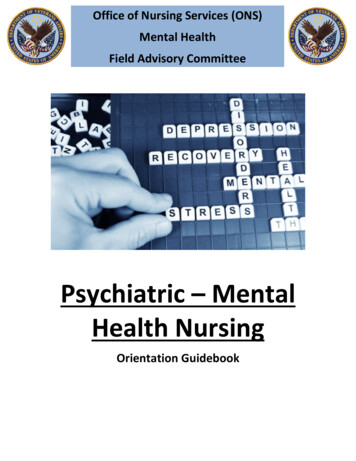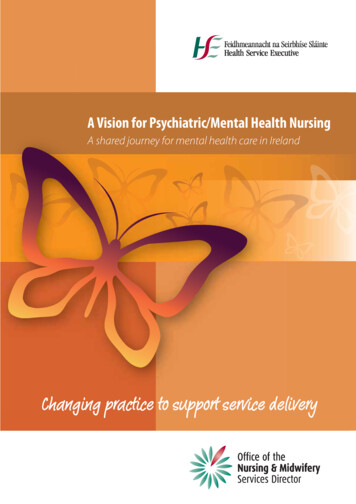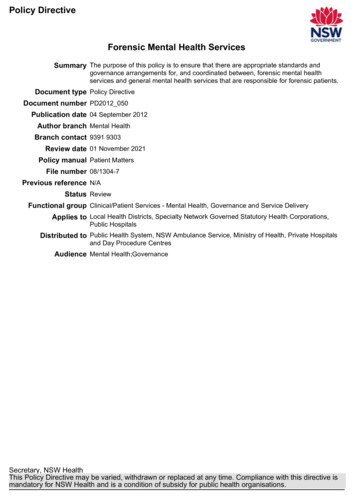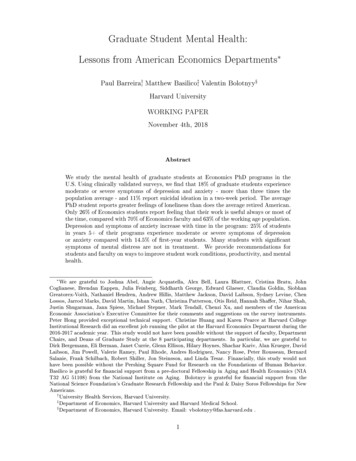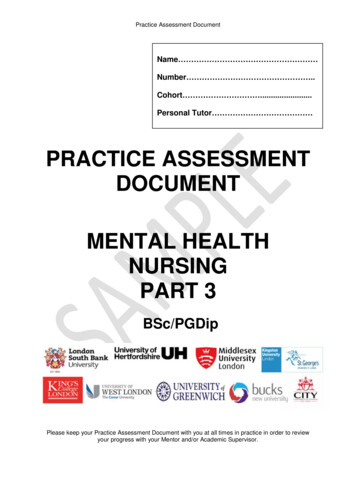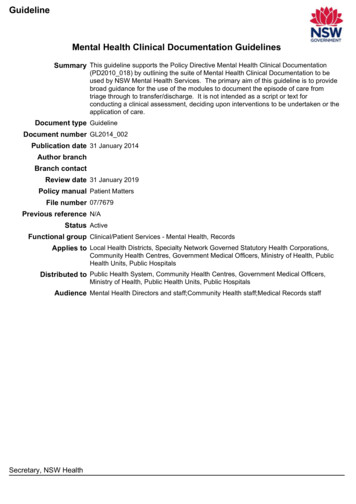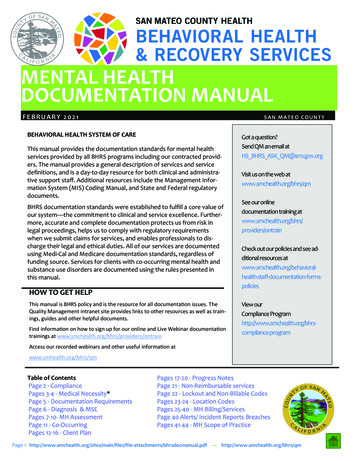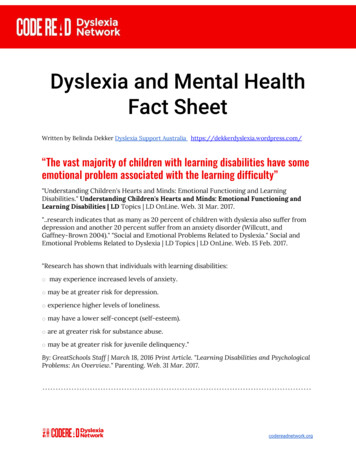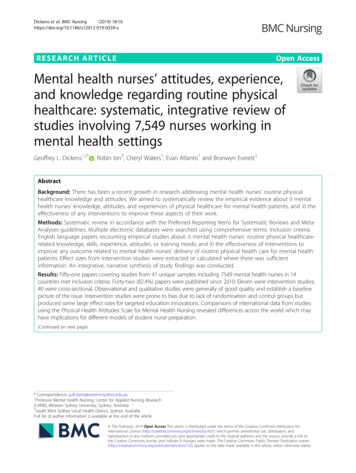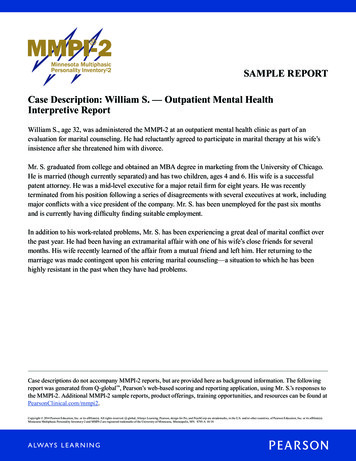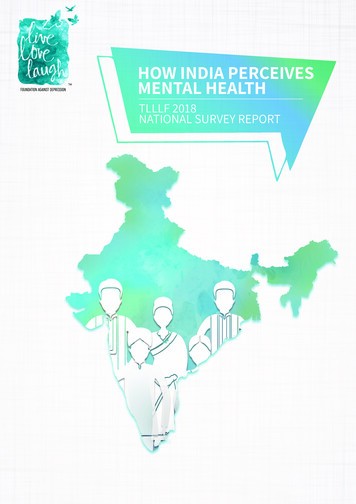
Transcription
HOW INDIA PERCEIVESMENTAL HEALTHTLLLF 2018NATIONAL SURVEY REPORT
CONTENTS0205ExecutiveSummaryIntroduction tothe study07Findings0709Mental health awareness & stigmaAttitude towardsmental illness1214Attitude towards seeking helpfor their own mental illnessThe three segments of thegeneral public based on theirattitude towards mental health17Conclusion andRecommendations
EXECUTIVESUMMARYThe WHO estimates that 20% of Indians may sufferfrom depression in their lifetime. Another survey,the National Mental Health Survey in India (201516) has estimated that only about 10-12% ofpeople suffering from depression in India gettreated . This high treatment gap, if notaddressed, would result in an increased diseaseburden. In light of this increasing need for supportand care for persons with mental illness, The LiveLove Laugh Foundation approached Kantar Publicto understand public perceptions and attitudestowards mental health. The study covered 3,556males and females in roughly equal proportions,a c r o s s e i g h t c i t i e s o f t h e co u n t r y. T h emethodology consisted of a mix of qualitative indepth interviews, as well as quantitative face-toface structured interviews.The survey revealed that although people showedhigh awareness about mental illness [about 87%participants using at least one term that relates tothe names and symptoms of mental illnesses],they also showed high stigma against people withmental illness [with about 62% participants usingderogatory terms like retard (47%) or crazy /mad / stupid (40%) or careless / irresponsible(38%) to describe people with mental illness]. Ofthe respondents who showed awareness aboutmental illness (87%), the ones showing stigmamade up 71%. This indicates that just increasingawareness about mental illness might not beenough a holistic programme on mental healthwill also need to address the strong stigmaassociated with it.1http://www.searo.who.int/india/depression in india.pdfA majority of participants appreciate theimportance of social support for people withmental illness, but with reluctance. Data suggeststhat there are people who are willing to offer helpbut there is a clear distinction in the attitudeshown towards the inclusion of people withmental illness in workplaces andneighbourhoods. While 40% of respondents feelthat it is frightening to have people with mentalillness in their neighbourhoods (as seen earlier),57% feel that no one has the right to exclude them.The presence of a strong stigma towards peoplewith mental illness makes it dif cult for them toreach out for help. This also explains why 54% ofthe survey participants claimed that they werevery likely to visit a doctor to discuss mentalhealth.The study revealed three broad segments ofpeople based on their attitudes towards mentalillness.Segment 1 (27%): A group indicating support forpeople perceived as having mental illness.They do not discriminate against people withmental illness and predominantly believe that itcould happen to anyone.02
Segment 2 (47%): Those who indicate highjudgement against people perceived as having amental illness.This is the largest segment of the generalpopulation and includes people who are relativelymore aware of mental illnesses and theirassociated symptoms, but also display somestigma against people with mental illness. Whilethe individuals in this segment sympathise withpeople with mental illness, and voice the need forequal job opportunities for them, they themselveswould like to keep a safe distance. The stigmashown by this segment, however, is not as severeas shown by individuals that constitute segment 3.Segment 3(26%): A group indicating fear ofpeople perceived as having mental illness.This segment comprises of people who arefrightened of living in the same neighbourhood as03and interacting with someone suffering frommental illness.The stigma present in their immediate communitymight make it dif cult for people with mentalillness to talk about their problems openly. Thefear of being labelled or judged can keep peoplefrom openly admitting to having any mentalillness. People are also likely to remain in denial ofthe possibility that mental illness can occur tothem, sometimes believing that these ailmentsare caused by having a weak mind . Measures toovercome mental illnesses such as counselling orvisiting a psychologist for treatment aremisinterpreted as weakness or failure . There is aneed for the normalisation of mental health, aswell as for more open conversation around thesubject, so as to increase awareness and reducestigma in order to make a positive change in theattitudes of the general population.
INTRODUCTIONTO THE STUDYThe Live Love Laugh Foundation approachedKantar Public to understand the mental healthlandscape in India. The objective of this study wasto gauge the level of awareness about mentalhealth concerns, as well as to discern the publicperceptions and attitudes towards peoplesuffering from mental illness.Research objectives of the survey1234TO MEASURE THETO UNDERSTANDTO EXPLORE THETO IDENTIFYLEVEL OFTHE LEVEL OFATTITUDESVARIOUS STIGMASAWARENESS ANDSENSITIVITYTOWARDS MENTALASSOCIATED WITHKNOWLEDGE ABOUTTOWARDS THEHEALTHMENTAL HEALTHMENTAL HEALTHTOPICISSUESThe study covered 3,556 participants from thegeneral population both men and women, acrosseight cities of India (two from each of the fourgeographical zones of the country).CHART 513%Kanpur14%Pune12%Base: All:355612%Patna
A representation was maintained across variousage-bands (within 18 to 45 years) and socioeconomic classes so as to cover the knowledge,attitude and behaviour of people across thedifferent economic stratas, and various stages oflife.The research methodology involved aco m b i n at i o n o f st r u ct u re d q u a n t i tat i v einterviews, along with in-depth qualitativeinterviews. Quantitative interviews were carriedout face-to-face by trained interviewers usingComputer-Assisted Personal Interviewing (CAPI)in the respondents homes. Interviewing tookplace between the months of October andNovember, 2017. Qualitative in-depth interviewswere conducted by trained moderators. Theycovered 12 interviews with the general populationand three with mental health experts. The indepth interviews helped us gain insight into theprobable reasons for certain kinds of attitudes andbehaviour displayed towards mental health.06
#1FindingsMental health awareness & stigmaIn this study, we explored the Awareness(knowledge and perception) about health, mentalhealth and its disorders, and the varioustreatment methods across eight cities in India. Byasking the question, what does being healthymean to you? What else? , we came to understandCHART 247% associate having a sound mind withbeing essedRetardCrazy/ mad/ stupidIrresponsible/ carelessSpaced out/ day-dreamerCannot connect with othersEasily distractedSadness or griefCleans too muchAlzheimer sBorn with a brain defectProne to violence0757% associate being healthy with happinessHow would you describe a person with mental illness?Talk to themselvesBase: All:3556how the respondents de ned being healthy :AwarenessStigma
To capture the response on how the participantswould identify a person with mental illness, theywere asked How would you describe a mentally illperson ? The respondents were not promptedwith any clues related to clinical terms for mentalillnesses.Most people link mental illness with symptoms ofsevere mental illness [56% say that a sign of aperson with mental illness is that they talk tothemselves (symptom of Schizophrenia); 30%link mental illness with a person who cleans toomuch (symptom of Obsessive CompulsiveDisorder)]. Some people mention the illnessesthemselves (49% link Depression with mentalillness; 29% name Alzheimer's ) as a response tothis question. About 87% of respondentsshowcased some level of awareness about mentalillness by giving at least one of the aboveresponses.careless / irresponsible (38%) to describe peoplewith mental illness, suggesting that there is a highlevel of stigma attached to these illnesses.Of the respondents who showed some awarenessabout mental illness (87%), 71% also used termsassociated with stigma. These ndings indicatethat to create a holistic mental health programme,one will need to look into both increasingawareness about mental health and reducing thestigma that is associated with it, simultaneously.When people get to know thatyou are mentally sick, they startthinking differently of you.People/Peers start calling suchpersons PAGAL. Even if you callsomeone pagal in jest, othersaround may start thinking s/heis mad.Male, 39, MumbaiAt t h e s a m e t i m e , a b o u t 6 2 % o f s u r ve yparticipants used one of the following terms suchas retard (47%), crazy / mad / stupid (40%) or08
#2FindingsAttitude towardsmental illnessThe survey included statements to study a rangeo f att i t u d e s to wa rd s m e n ta l i l l n e s s , b yincorporating 22 items derived from the 40-itemCommunity Attitudes toward the Mentally Ill(CAMI) scale 2. The questionnaire, items andscales were adapted for the Indian context andpre-tested in the survey locations before beingnalised. The statements included a wide range ofissues, from attitudes towards people with mentalillness to opinions on services provided for peoplewith mental health issues. Respondents wereasked to give their opinion on each attitudestatement, using a 3-point scale Agree , NeitherAgree nor Disagree and Disagree .The 22 attitude statements covered thefollowing four broad themes:1. Fear and exclusion of people with mental illness2. Awareness and tolerance of mental illnessCHART 33. Degree of community integration of people withmental illness4. Perceived causes of mental illnessA majority of the respondents (60%) agree withthe statement that one of the main causes ofmental illness is the lack of self-discipline andwillpower and another 60% feel that mentallyunhealthy people should have their own groupsso as to not contaminate healthy people . Nearlyhalf of the participants (46%) have said that theywould like to keep a safe distance from someonewho is depressed.Many agreed with the statement that sitting with/talking to a mentally unhealthy person coulddeteriorate the mental health of a healthy person(41%) and that it is frightening to think thatpeople with mental problems live in ourneighbourhoods (40%).Attitude towards mental illnessPeople with mental illnesses should not be given anyresponsibility68%One of the main causes of mental illness is the lack ofself-discipline and will-power60%Mentally unhealthy people should have their own groupshealthy people need not be contaminated by them60%Most women who were once patients in a mental hospitalcannot be trusted as babysittersOne should keep safe a distance from someone who isdepressedPeople suffering from mental illness are always violentSitting with / talking to a mentally unhealthy personcould deteriorate the mental health of a healthy personIt is frightening to think that people with mentalproblems live in our neighborhoods0949%46%44%41%40%% of people agreeingBase: All:3556
However, a majority of respondents appreciatethe importance of social support for people withmental illness. While 68% agree that we have theresponsibility of providing the best possible careto people with mental illnesses, the number ofCHART 4people who believe that no one has the right toexclude people with mental illness from theirneighbourhoods is comparatively lower (57%).57% of respondents also state that they would notavoid working with a person with mental illness.Social inclusion of the patientsWe have the responsibility of providing the bestpossible care to people with mental illnessThe best therapy for many people with mentalillnesses is to be part of the ever ydaycommunity68%67%If a friend has a problem with his/her mentalhealth, I will advise him/her to see a mentalhealth professional.65%57% 57%I will not avoid working with someone with amental health problemNo-one has the right to exclude people withmental illness from their neighborhood% of people agreeingBase: All:3556In order to explore this attitude in further detail,respondents were asked about their feelingstowards people with mental illness. While thereexists widespread sympathy towards people withmental illness with more than three-fourths ofsurvey participants stating that they wouldalways feel sympathetic towards them, they alsoexhibit feelings of fear (14% would always befearful), hatred (28% feel hatred sometimes oralways) and anger (43% feel angry sometimes oralways) towards people with mental illness. Morethan a quarter admitted that they would always beindifferent towards people with mental illness.This admission of the general public to theirfeelings towards people with mental illness againindicates the prevalent stigma in society.10
CHART 5Feelings towards mentally illHatred8%Disgust9%Annoyance8%Anger8%FearApathy / s34%33%76%Sympathy1165%30%EmpathyBase: All:355670%Sometime22%NeverDon't know / Can't say5%2%
#3FindingsAttitude towards seeking helpfor their own mental illnessWhile 54% of survey participants displayed highlikelihood towards visiting a doctor to discussCHART 6their mental health, another 28% were somewhatlikely to discuss their mental health concerns witha doctor.54%Would you visita doctor if youhad a mentalhealth problem?Very Likely28%Base: All:3556Somewhat Likely14%Not LikelyThe results indicate that there is a high awarenessof available treatment for mental illness - 92% ofpeople agree that visiting a specialist doctor canhelp a person with mental illness recover.Additionally, 71% of respondents agreed thatmedication can be an effective treatment forpeople with mental health problems and 69%CHART 74%Don't Know/Can't Sayagreed that counselling can be an effectivetreatment for people with mental healthproblems . There was also a favourable responseto the statement people with severe mentalhealth problems can fully recover , with 63%agreeing to it.Knowledge of treatment availablePeople suffering from a mental illnessshould visit a specialist doctor92%Medication can be an effective treatmentfor people with mental health problems71%Counselling can be an effective treatmentfor people with mental health problems69%63%People with severe mental health problemscan fully recover% of people agreeingBase: All:355612
When participants were asked if they personallyknew of someone with mental illness, 17% saidyes. Nearly half of those respondents said that thisperson was an acquaintance and only a mere 2%admitted that the person mentioned wasthemselves.The people in the society arealways ready to laugh and makejokes. People will make fun of apatient or gossip about him/herand might call him/her mad.Male, 19, MumbaiCHART 8Yes5%No/Don't Know14%3% 2%AcquaintanceFriendOther family83%17%Immediate familyWork colleague15%Base: All:355613OtherSelf16%49%
#4FindingsThe three segments of thegeneral public based on theirattitude towards mental healthThe 22 attitude statements that were analysedabove, were also used to segment the generalpopulation based on their responses. We ran acluster analysis on the statements and it showedthree clear groups of people based on theirattitude towards people with mental illness.CHART 9ThreebroadsegmentsSegment 1 (27%): Indicating Support forpeople perceived as having mental illness.26%27%47%Segment 2 (47%): Indicating higherjudgement against people perceived ashaving mental illness.Segment 3 (26%): Indicating fear of peopleperceived as having mental illness.* Base for cluster analysis was 3175 casesSegment 1: Those who indicate support forpeople perceived as having a mental illness: Thisset includes people who do not discriminatea ga i n st p e o p l e w i t h m e n ta l i l l n e s s a n dpredominantly believe it may happen to anyone.They agree that a person, after suffering from amental illness, can recover completely. Awarenessof the symptoms of various mental illnesses isrelatively high among this set. The segmentidenti es mental illness mostly with depression(62%), sadness (38%), and incapability ofmaking decisions (25%).58% of these respondents believe that a healthylife includes having a sound and healthy mind.About 50% feel that mental illness is more harmfulthan physical illness. As many as 26% within thissegment admit to knowing someone sufferingfrom mental illness as opposed to 17% at anoverall level. They also showcase higheragreement to following attitudes: Virtually anyone can develop a mental illness(86% within the segment agree vs. 70% overall) People with severe mental health problemscan fully recover (82% within the segmentagree vs. 63% overall) We have the responsibility of providing the bestpossible care to people with mental illness(86% within the segment agree vs. 68% overall)14
If a friend has a problem with his/her mentalhealth, I will advise him/her to see a mentalhealth professional (86% within the segmentagree vs. 65% overall)This segment is relatively bigger in cities like Delhi,Kanpur and Patna. These responses wereobtained from a relatively younger age group (18to 24 years), as well as a comparatively lowersocio-economic background and educationallevel. With regards to mental illness, people fromthis segment are more likely to go to a doctor / GPfor help, and are relatively more comfortabletalking to a friend, family member or employerabout their illness, when compared to the othersegments.S e g m e n t 2 : T h os e w h o i n d i cate h i g h e rjudgement against people perceived as having amental illness: This is the largest segment of thegeneral population and includes people who arerelatively more aware of mental illnesses and theirassociated symptoms, but display stigma againstpeople with mental illness. This segment ofparticipants associate mental illness with termssuch as Alzheimer s (34%), Split Personality(29%), and Anorexia (25%) on one hand whilealso describing a person with mental illness asirresponsible and careless (41%).They showcase higher agreement with thefollowing attitudes: One should keep safe a distance from someonewho is depressed (80% within the segmentagree vs. 46% overall) Sitting with / talking to a mentally unhealthyperson could deteriorate the mental health of ahealthy person (68% within the segment agreevs. 41% overall)15 People with mental health problems shouldhave the same rights to a job as anyone else(90% within the segment agree vs. 63% overall)This segment is relatively bigger in cities likeKolkata, Hyderabad and Mumbai. Therespondents who fall into this segment are mostlyfrom higher socio-economic background and mayhave a relatively higher level of education. Theyshow a less likelihood to visit a doctor / GP or talkto a friend, relative or employer with respect tomental health.Segment 3: Those who Indicate fear of peopleperceived as having a mental illness: Thissegment shows the highest degree of stigmatowards people with mental illness. This segmentassociates mental health with terms like retard(50%) to identify a person with mental illness.Additionally, more people in this segment believethat a person suffering from mental illness isprone to violence (25%).This segment is fearful of living in the sameneighbourhood as someone suffering frommental illness. People in this segment showapathy towards people with mental illnesses.Additionally, they do not believe that people withmental illness should be included back intosociety, post their recovery. They do not agree thatmedication and counselling can be effectivetreatments for people with mental illness. Thissegment indicates lowest agreement to thefollowing attitudes: People with severe mental health problems canfully recover (only 41% within the segmentagree vs. 63% overall) Medication can be an effective treatment forpeople with mental health problems (only 44%
within the segment agree vs. 71% overall) Counselling can be an effective treatment forpeople with mental health problems (only 56%within the segment agree vs. 69% overall) Virtually anyone can develop a mental illness(only 54% within the segment agree vs. 70%overall) There is nothing wrong or crazy about peoplewith mental illness (only 41% within thesegment agree vs. 63% overall) The best therapy for many people with mentalillness is to be part of the everyday community(only 49% within the segment agree vs. 67%overall) Mental illness is an illness like any other (only25% within the segment agree vs. 53% overall) No-one has the right to exclude people withmental illness from their neighbourhood (only37% within the segment agree vs. 57% overall)This segment is relatively bigger in cities likeBangalore and Pune. The survey participants fromthis segment are relatively older (35 to 45 years)and are more likely to have mid-level educationalquali cations. They show a lesser likelihood ofvisiting a doctor / GP or talking to a friend, relativeor employer with regards to mental health.Demographic differences across segments: Bythis segmentation, there does not seem to bemuch of difference by gender; however, thoseindicating support for people with mental illnessare relatively younger than those indicatingstigma and fear. A larger number of people withhigher levels of education and better socioeconomic class were seen to have higher levels ofawareness of mental health concerns while alsoindicating more stigma and fear towards peoplewith mental illness. This segmentation, therefore,suggests that there is a greater amount of supportfor people with mental illness from places thatpossess lower levels of education and lower socioeconomic backgrounds.16
CONCLUSION ANDRECOMMENDATIONSAs seen in the report above, stigma and awarenessare two separate issues that need to be addressedin order to tackle the burden of mental illness inIndia. If individuals continue to view mentalillness with apprehension and resistance, it willremain dif cult for people with mental healthconcerns to seek the support that they require.According to our qualitative analysis, people withmental illness are likely to avoid discussing theirmental health concerns openly, due to the fear ofbeing labelled or judged. Furthermore, somepeople believe that mental illness can onlyhappen to people who are mentally weak andpeople who have too much money and time . Forthese individuals, seeking support from a mentalhealth professional is seen to be a sign ofweakness .CHART 10Cannot happen to me! Only Mentally weak peopleget mentally illIn-denialIt is a rich person's disease - Celebrities or peoplewith money feel it as they have too much timeIt is a part of life It doesn't deserve specialattention unless it gets bigCounselling weakness,giving upFear ofstigmaPsychologists are Doctors for mad peopleChildren don't need such doctors unless there is anissue in their upbringingThe need of the hour is to sensitise and educateindividuals about the signs and symptoms ofmental illness, while normalising the idea ofseeking support for themselves and their lovedones. There needs to be more open discussion and17dialogue with the general public (and not just withexperts) on this subject. Therefore, to create abetter mental health landscape in the country, atwo-pronged approach will be required - toincrease awareness and to reduce stigma.
www.thelivelovelaughfoundation.org
The Live Love Laugh Foundation approached Kantar Public to understand the mental health landscape in India. The objective of this study was to gauge the level of awareness about mental The study covered 3,556 participants from the general populationboth men and women

